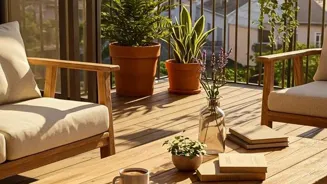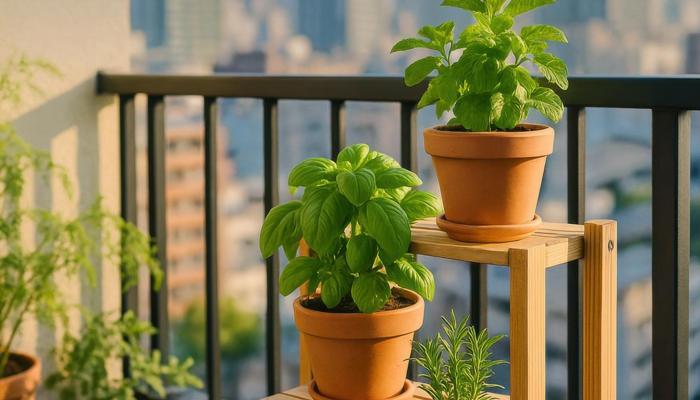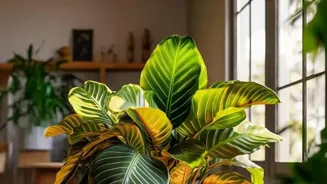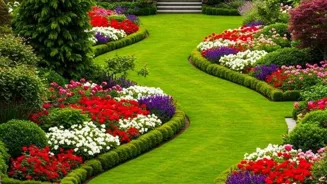Unlock the secrets to a lush terrace garden oasis in the city jungle! Dive into expert tips for a green haven!
Mumbai, Oct 26 – Sick of staring at concrete all day? Dreaming of a personal slice of paradise,
right above your head? Well, listen up, urban dwellers! Creating a lush, thriving terrace garden in our packed Indian cities might seem like a Mount Everest-sized task, but trust us, it's totally doable.
You just need a little bit of planning, a dash of elbow grease, and these insider tips from gardening experts to help you transform your rooftop into a green haven.
Forget those boring, bare terraces; we're talking about a vibrant space bursting with flowers, herbs, and maybe even a sneaky little veg patch! So, grab chai, get comfy, and let’s get growing!
Check terrace's load-bearing capacity before planting for safety. Waterproof well
Before you even think about planting a single marigold, you absolutely need to check your terrace's load-bearing capacity. This is super important. Terracotta pots overflowing with soil are surprisingly heavy, and the last thing you want is to compromise the structural integrity of your building.
Consult with a structural engineer or a qualified architect. They can assess your roof and tell you exactly how much weight it can safely hold. Don't skip this step! Safety first, people! Also, make sure you have proper waterproofing.
Leaks are the enemy of terrace gardens and your downstairs neighbours! Invest in good quality waterproofing membrane to protect your roof from water damage caused by irrigation and rain. This small investment can save you big headaches (and repair bills) down the line.
Remember, a happy building equals a happy garden!
Plan garden layout based on sunlight, space, drainage for optimal plant growth
Next, plan the layout. How much sunlight does your terrace receive? What kind of space do you have available? Create a rough sketch of your garden, marking out areas for different types of plants, pathways, and seating.
This will help you visualize the final product and ensure that you make the most of your space. Group plants with similar needs together.
Plants that love full sun should be placed in the sunniest spots, while those that prefer shade should be placed in more sheltered areas and consider the water drainage. Proper drainage is vital to prevent waterlogging, which can lead to root rot and other plant diseases.
Use well-draining soil and ensure that your pots and planters have drainage holes. You can also add a layer of gravel or pebbles at the bottom of your containers to improve drainage.
Optimize soil for thriving terrace garden with proper drainage & nutrients
Forget the random roadside soil! Your plants deserve better. For a thriving terrace garden, you need a well-draining, nutrient-rich soil mix. You can buy pre-mixed potting soil from your local nursery, or you can create your own blend.
A good mix typically includes garden soil, compost, and cocopeat (which helps retain moisture). Avoid heavy clay soils, as they tend to get waterlogged and can suffocate your plants’ roots. Add organic matter like compost or well-rotted manure to improve the soil’s fertility and drainage.
This will provide your plants with the nutrients they need to grow strong and healthy. Consider using raised beds or containers to improve drainage and make gardening easier on your back. Raised beds also allow you to create a custom soil mix that is perfect for your plants.
In addition, mulch the soil surface with straw, wood chips, or other organic materials to help retain moisture, suppress weeds, and regulate soil temperature. This is especially important during the hot summer months, when the soil can dry out quickly.
Choose local plants for terrace gardening; consider climate and container suitability
This is where the fun begins! But don't get carried away buying every pretty flower you see. Think about your local climate. Hyderabad's scorching summers demand different plants than Bangalore's pleasant year-round weather.

Opt for native or well-adapted species that can withstand the local conditions. For sunny terraces, consider heat-tolerant plants like bougainvillea, hibiscus, and succulents. In shadier spots, try ferns, begonias, and impatiens. Choose plants that are suitable for container gardening.
Look for varieties that are compact and have shallow root systems. These types of plants are less likely to outgrow their containers and require less maintenance. And don't forget edibles!
Herbs like basil, mint, and coriander thrive in containers, and tomatoes, chillies, and brinjals can also be grown successfully on your terrace. Another smart thing is to grow variety of plants. Don't just stick to flowers, throw in some vegetables
Watering tips: Check soil before watering, avoid overwatering
Watering is crucial, but overwatering is a common mistake. Soggy roots are unhappy roots. Check the soil moisture before watering. If the top inch feels dry, it's time to water. Water deeply and thoroughly, until water drains out of the bottom of the pot.

Avoid watering the foliage, as this can encourage fungal diseases. Invest in a good watering can or hose with a gentle spray nozzle. Avoid watering during the hottest part of the day, as water can evaporate quickly and scorch your plants.
The best time to water is early in the morning or late in the evening. Consider installing a drip irrigation system, especially if you have a large terrace garden. Drip irrigation delivers water directly to the roots of your plants, which helps conserve water and reduces the risk of overwatering.
Also, collect rainwater to water your plants. Rainwater is naturally soft and free of chemicals, which makes it ideal for plants.
Choose healthy plants, spot pests early, use natural solutions, attract beneficial insects
No garden is immune to pests and diseases, but you can minimize problems by choosing healthy plants and practicing good hygiene. Inspect your plants regularly for signs of pests or diseases. Look for things like chewed leaves, spots, or discoloration.
If you spot a problem, act quickly to prevent it from spreading. Avoid using harsh chemical pesticides and herbicides. Instead, opt for natural and organic solutions. Neem oil is a great all-purpose pesticide that is effective against a wide range of pests.
You can also use insecticidal soap or homemade remedies like garlic spray or chilli spray. Encourage beneficial insects to visit your garden. Ladybugs, lacewings, and praying mantises are all natural predators that can help control pests.
Plant flowers that attract these beneficial insects, such as marigolds, sunflowers, and zinnias.
Fertilize plants regularly for healthy growth and consider repotting every 1-2 years
Even with the best soil, your plants will eventually need a little extra boost. Fertilize regularly with a balanced fertilizer that is specifically formulated for container gardening.
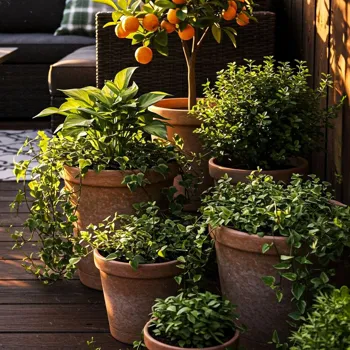
Follow the instructions on the fertilizer label carefully, and avoid over-fertilizing, as this can damage your plants. You can also use organic fertilizers like compost tea, seaweed extract, or bone meal.
These fertilizers are slow-releasing and provide your plants with a steady source of nutrients. Apply fertilizer every two to four weeks during the growing season. Reduce or stop fertilizing during the dormant season, when your plants are not actively growing.
Also make sure that you re-pot your plants every one or two years to replenish the soil and provide them with more space to grow. When re-potting, choose a pot that is slightly larger than the previous one and use fresh potting soil.
And finally, consider adding a layer of mulch to the soil surface to help retain moisture, suppress weeds, and regulate soil temperature. This will help your plants stay healthy and vigorous.
